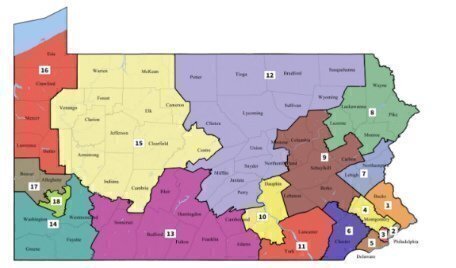A group of Democratic voters in Pennsylvania told a federal court on Friday that, if it barred the use of a congressional election map drawn up by the state’s Supreme Court, candidates seeking all 18 of the state’s seats in the U.S. House of Representatives would have to run statewide rather than in 18 separate districts.
 That was one of the main arguments the 18 voters made as they and two state officials who run elections filed their objections to a lawsuit in federal court seeking to bar the use of the state court’s election map. Among a handful of other points, the filings contended that the federal court sitting in Harrisburg simply has no authority to second-guess what the state Supreme Court has done about this year’s congressional elections.
That was one of the main arguments the 18 voters made as they and two state officials who run elections filed their objections to a lawsuit in federal court seeking to bar the use of the state court’s election map. Among a handful of other points, the filings contended that the federal court sitting in Harrisburg simply has no authority to second-guess what the state Supreme Court has done about this year’s congressional elections.
A three-judge panel is weighing a lawsuit, based on the federal Constitution, against the court-drafted plan that is to replace a 2011 map that the state’s highest court struck down as an unconstitutional partisan gerrymander. The 2011 map has been used in three congressional elections, and each time the result has been 13 Republican winners and five Democratic winners, even though statewide voting for House seats has been almost evenly divided.
While two GOP legislative leaders and eight current GOP members are trying to get the federal court to reinstate the 2011 map for this year’s elections, two other GOP leaders of the legislature have a request pending at the U.S. Supreme Court to block the use of the state court’s map. That case is expected to unfold next week, either before Justice Samuel A. Alito, Jr., or the full Court. Alito has previously refused to block the state court from drawing its own House districts.
Friday’s filings in the federal court in Pennsylvania’s capital city were reactions to the GOP challenge there. The 18 Democratic voters were among those who had sued in state court, claiming a partisan gerrymander, and won in that court’s 4-to-3 decision in January. They were joined in the state court challenge by the League of Women Voters, but the federal court refused to allow that group to become a full party in the federal case. Also barred as a full party was a new group working across the country to challenge gerrymanders, the National Democratic Redistricting Commission. (All or at least most of the arguments those two groups planned to put forth were covered in the filings by the voters and state officials.)
The Democratic voters are defending the state court plan even as they seek to get the GOP lawsuit thrown out. Two state election officials have been sued in the federal case, and their filings, too, mounted a multi-faceted protest to the GOP lawsuit. Under orders from the federal court, the two attempted to avoid overlapping arguments in the filings they submitted Friday, but there were some parallels.
A prominent argument in the voters’ two filings (one brief opposing the GOP demand for an order requiring the use of the nullified 2011 map and one asking for dismissal of the GOP case) was the suggestion that candidates for the House this year might have to run statewide, in some kind of sorting system for the 18 seats. (Seven U.S. states now elect their House members statewide, but that is because each of them has only one Representative, due to their small population totals.)
A federal law provides that, if a state loses one of its seats in the House after a new ten-year census (as Pennsylvania did), if the state does not adopt a new congressional district map, and if it does not do so in time for a new map to be drawn up, then that law requires that all candidates for the state’s House seats must run in at-large elections – that is, statewide.
The Democratic voters argued that this law is mandatory, and that it would go into effect in Pennsylvania if the federal court were to bar the use of the map drawn up by the state’s highest court – as the GOP challengers want. That would happen, the voters contended, because there is no legal way for the federal court to require the use of the nullified 2011 map, and thus statewide elections would be the only alternative left; there is no time left for another map, they said.
The 2011 map cannot be ordered into effect, according to that legal brief, because it does not satisfy the Pennsylvania state constitution, under the state Supreme Court ruling that the voters say cannot be second-guessed by the federal court.
Both the voters’ two briefs and the separate brief filed by the two state election officials raise a handful of points, all suggesting that it has long been clear in American law that those who lose a case in state court cannot, on their own or through their allies, try to pull out a victory for themselves by turning to a federal court.
The voters’ brief listed five separate points on that question, and the state officials added their own.
Each of those briefs did suggest that, if the three judges in Harrisburg are not prepared to throw out the GOP lawsuit, they at least should take no action on it until after they see what happens with Justice Alito and perhaps the full Supreme Court in Washington. The Harrisburg court is scheduled to hold a hearing next Friday.
If the federal court does decide to rule on the federal constitutional arguments made in the GOP lawsuit, those arguments have no legal merit, the Friday filings asserted. The arguments are that the federal Elections Clause allows only a state legislature to draw House districts, and that Clause also requires state courts to allow the legislature adequate time to draw a legal map if one is struck down.
Meanwhile, the voters told the federal court that arrangements are moving forward to use the state court’s plan for the scheduled congressional primary on May 15. A separate election, using the 2011 map’s lines, is being held March 13 to fill a vacancy in the seat representing the state’s 18th District in southwestern Pennsylvania. That district has traditionally supported Republican winners, but recent polling has suggested that the race may be tightening there.
The May 15 primary will select candidates for all 18 seats in the House, and election experts have interpreted the state court’s map as likely to result in a delegation after the November general election of ten Republicans and eight Democrats, or possibly an even nine-to-nine split.
Legendary journalist Lyle Denniston has written for us as a contributor since June 2011 and has covered the Supreme Court since 1958. His work also appears on lyldenlawnews.com.






